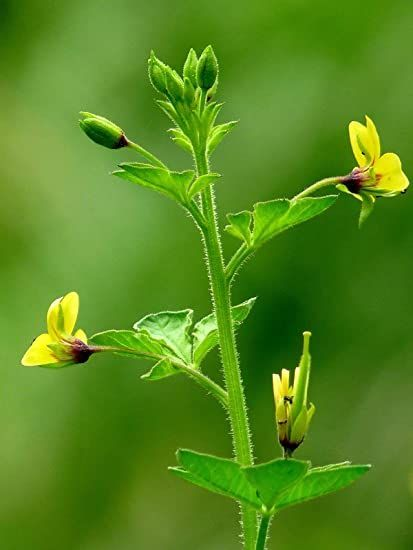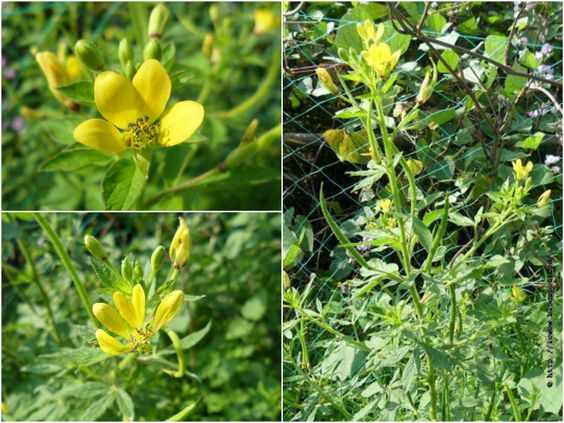The annual plant Cleome Viscosa is upright, branching, and has sticky leaves. It can reach heights of 40 to 150 cm. The plant is harvested from the wild to be used locally as a food source and medicine. Cleome Viscosa is occasionally grown in India, where it is becoming more well-liked as a less expensive alternative to cumin.
Its production is encouraged for marginal or degraded agricultural land because it is easier to grow than typical crops. Cleome Viscosa can be grown as an outdoor plant in your garden/verandah. Read on to find out all about the care tips, uses, and benefits of Cleome Viscosa.
See also: Oval leaf pondweed: Know how to grow and care for this houseplant

Source: Pinterest
See also: All about Striped Barbados Lily
What is Cleome Viscosa?
Cleome Viscosa is one of the many beautiful plants belonging to the tropical regions. It features gorgeous, blooming clusters of flowers with protruding long stamens and long-stalked petals. Its flowers come in different colours including pink, white, and yellow. Cleome Viscosa is often considered an invasive species and is commonly found during monsoons.
Cleome Viscosa: Key facts
| Common name | Asian spider flower |
| Type of plant | Pantropical |
| Height | Upto 1.5 m |
| Agroforestry use | Used as green manure in Ghana |
| Family | Cleomaceae |
| Native | Tropical Africa and Asia |
| Sunlight | Direct sunlight |
How to grow Cleome Viscosa?
- Cleome Viscosa prefers a light, fertile soil in an area that is warm, dry, and sunny with lots of space to grow.
- Three to four weeks after germination, Cleome Viscosa begin to blossom, and their life cycle lasts roughly three months.
- Since they are transient, the blooms open in the morning and close in the afternoon.
- Due to its sticky nature and potent odour, Cleome Viscosa is not destroyed by wildlife or attacked by insect pests.

Source: Pinterest
See also: How to design an indoor garden
How to care for Cleome Viscosa?
Keep these care tips in mind when maintaining Cleome Viscosa in your garden.
- Make sure that Cleome Viscosa receives maximum sun exposure for best results.
- Ensure that your garden soil is well-drained.
- Try planting Cleome Viscosa in large beds by themselves.
- Don’t use too much fertiliser.
What are the benefits of Cleome Viscosa?
- Cleome Viscosa is incorporated into food as a stimulant to increase appetite.
- A decoction is used to treat illnesses like colic and dysentery by acting as an expectorant and digestive stimulant.
- It is believed that chewing the leaves of Cleome Viscosa for a week will increase a woman’s chances of getting pregnant.
- The leaves of Cleome Viscosa are applied externally to cure wounds and ulcers, ease rheumatism, and treat herpes infections by acting as an anti-irritant.
- Rheumatoid arthritis, gonorrhoea, diarrhoea, and dysentery are all treated with decoctions of Cleome Viscosa .
- To treat piles, a decoction of the seeds is applied as a wash. The seed has 0.04% viscosin and 0.1% viscosic acid.
- For the treatment of earaches, a paste made from the root of Cleome Viscosa is applied externally.
- Given the beauty of the flowers, they are sure to add colour and vibrancy to your garden.
Cleome Viscosa: Toxicity
No part of Cleome Viscosa is considered at all toxic or harmful to either humans or pets. In fact, most parts of the plant are edible and have a variety of medicinal uses. You can safely plant Cleome Viscosa in your garden.
FAQs
Which family does Cleome viscosa belong to?
Cleome viscosa belongs to the family Cleomaceae.
Can you eat cleome viscosa?
Yes, the leaves can be cooked and eaten. The seeds can be substituted for mustard in curries, and the fruits can be pickled.
Housing News Desk is the news desk of leading online real estate portal, Housing.com. Housing News Desk focuses on a variety of topics such as real estate laws, taxes, current news, property trends, home loans, rentals, décor, green homes, home improvement, etc. The main objective of the news desk, is to cover the real estate sector from the perspective of providing information that is useful to the end-user.
Facebook: https://www.facebook.com/housing.com/
Twitter: https://twitter.com/Housing
Email: [email protected]












